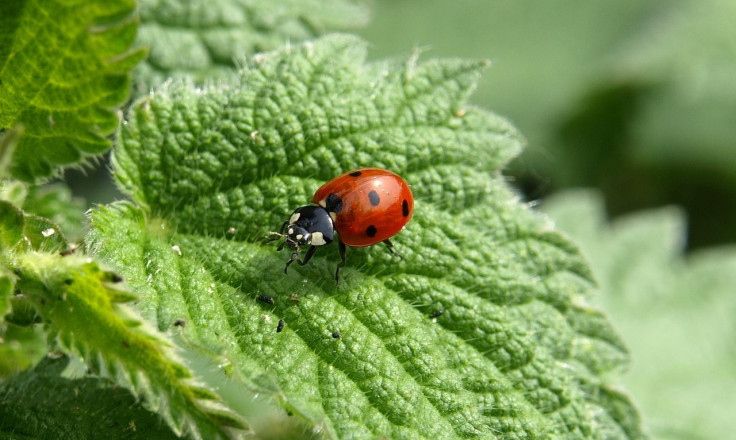'Apocalyptic' Number Of Ladybirds Swarming the UK: Here's Why Thousands Are Crawling Into British Homes
Ladybirds are appearing in large numbers across the UK this week

Across towns, villages and cities in the UK, residents have been startled to find windows, walls and ceilings suddenly covered with clusters of ladybirds. In some areas, the insects have been spotted crawling indoors, gathering around radiators, boiler cupboards and sunny corners of rooms. What began as a few sightings has now turned into a nationwide conversation and a viral trend online.
Videos showing hundreds of ladybirds blanketing brickwork and light fittings have spread across social media, with users describing scenes of 'invasions' and 'swarms'. Some say they've never seen so many at once, while others have raised concerns about whether the insects are dangerous or if something ecological is going wrong.
Experts are urging calm. They explain that while this year's ladybird surge is striking, it is not a sign of pestilence or imbalance but a seasonal event amplified by weather and biology. Warm conditions, a plentiful food supply and the insects' instinct to find shelter ahead of winter have combined to create this spectacle, which is largely harmless.
Warm Weather, Aphids and Autumn Behaviour
Scientists say the surge is unusual in scale but not unexpected. Ecologists explain that warm, dry weather and abundant food sources, particularly aphids, have led to a population boom. Professor Helen Roy of the UK Centre for Ecology and Hydrology said that when aphid numbers increase, ladybirds follow to feed on them.
Two seasonal behaviours are also influencing this clustering. As autumn approaches, ladybirds naturally seek warm, sheltered spaces such as lofts, cracks in walls and homes to hibernate. This 'overwintering' behaviour makes buildings attractive refuges. In addition, some species, notably the Harlequin ladybird (Harmonia axyridis), gather in large groups before hibernation and are more likely to enter houses than hide beneath bark or leaf litter.
Are They Harmless?
Most of the ladybirds seen are not harmful to people, though they can be a nuisance. The most visible are Harlequin ladybirds, an invasive species from Asia that often crowd around windows and light sources. When disturbed, they secrete a yellowish fluid that can stain surfaces and cause minor irritation.
Harlequins also carry a fungal disease, Laboulbeniales, which spreads among ladybirds but poses no risk to humans. Scientists say native British species are being displaced in some areas by the Harlequin's expansion, a biodiversity concern rather than a public health issue.
Why So Many, So Soon?
The UK's warm spring and summer created ideal breeding conditions, allowing multiple generations of aphids and ladybirds to develop. Homes are more vulnerable this year because open windows, warm surfaces and cracks provide easy entry points for insects seeking shelter.
Ecologists note that this year echoes past 'boom years', such as 1976, when similar weather patterns produced dramatic surges in ladybird populations. These spikes are temporary and usually taper off once cooler temperatures set in.
Just seen a news report about ladybirds swarming UK homes and early on, I saw two or four crawling on my window and just last week, I had some on my hoodie when I went for a stroll
— Deano Jay Halliwell (@DeanoJHalliwell) October 6, 2025
Just heard Jo Whiley on Radio 2 mention it’s been “ladybird invasion day” around the country today. There have been thousands of them here, all trying to get into my house. I’ve never seen anything like it! Anyone else experiencing this? pic.twitter.com/0dFcnCDtUx
— VenetiaJane's Garden (@VenetiaJane) October 6, 2025
Ladybugs everywhere!! There are literally hundreds on my house and they land on me in droves. 🐞🐞🐞🐞🐞🐞🐞 pic.twitter.com/JVsBRNyfjG
— Laura Frost - Contemporary Fiction Author (@LFrostWrites) October 3, 2025
Anyone else suffering from a Plague of ladybirds 🐞🐞🐞🐞🐞🐞🐞🐞🐞🐞🐞🐞🐞🐞🐞🐞🐞🐞🐞🐞🐞🐞🐞🐞🐞🐞🐞🐞🐞🐞🐞🐞🐞🐞🐞🐞🐞🐞🐞🐞🐞🐞🐞🐞🐞🐞🐞🐞🐞🐞🐞🐞🐞🐞🐞🐞Thousands flying everywhere in West Norfolk 🐞🐞🐞🐞🐞🐞🐞🐞🐞🐞🐞🐞🐞🐞🐞🐞🐞🐞🐞🐞🐞🐞🐞🐞🐞🐞🐞🐞🐞🐞🐞🐞🐞🐞🐞🐞🐞 pic.twitter.com/oAkAIwXjVh
— Russell ChalkStreamsInCrisis 🦇🦎🦇🦎 (@RussellB1ggs) October 6, 2025
What Happens Next
Experts stress that the sight of thousands of ladybirds entering homes is not a sign of infestation but a natural reaction to the changing season. As temperatures drop, most will settle into hibernation and disappear from view until spring.
While their presence can be inconvenient, ladybirds remain beneficial predators of aphids and play a vital role in gardens and ecosystems. Their sudden arrival is a vivid reminder of how wildlife behaviour shifts in tune with the British autumn.
© Copyright IBTimes 2025. All rights reserved.




















